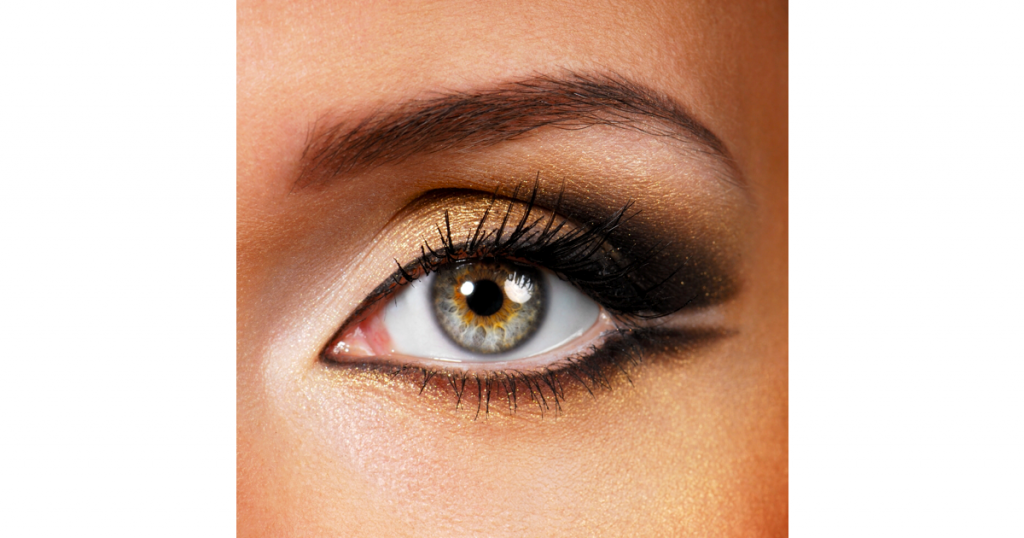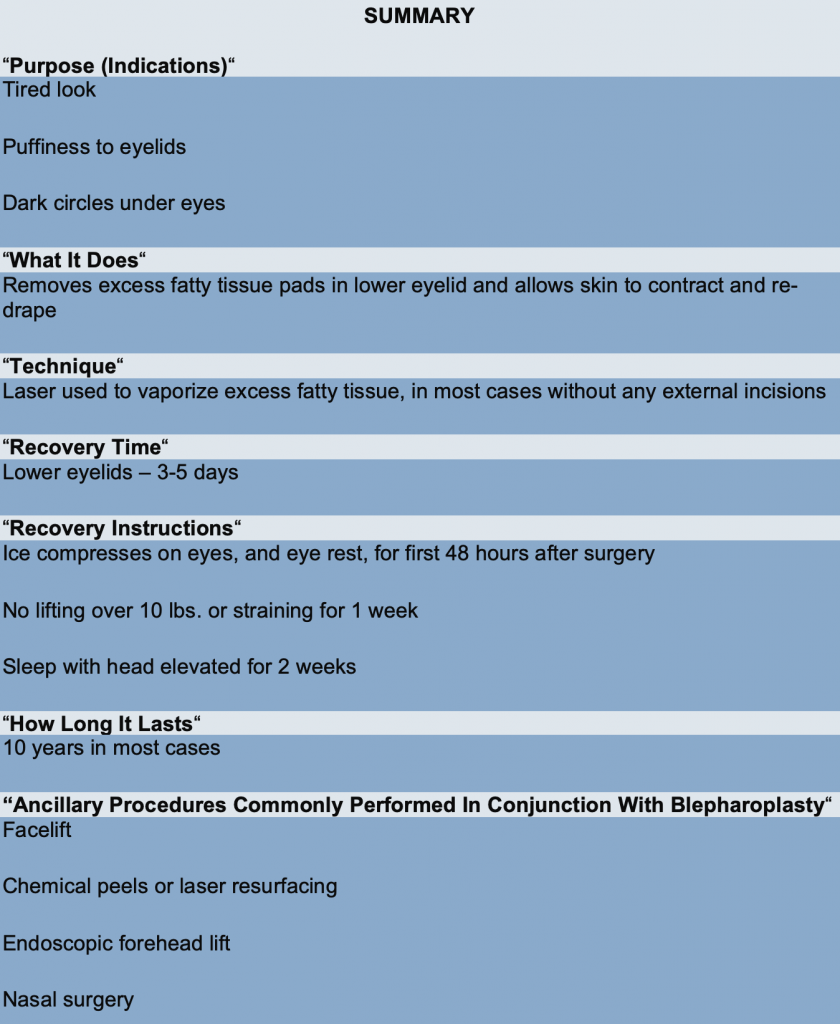
Some people refer to the eyes as the “windows of the soul.” They are certainly the focal point of the face and our eyes are one of the first areas to show aging. Increased laxity of skin can portray a tired, sad, or melancholy appearance when in actuality we feel otherwise. Blepharoplasty surgery, or the eyelid tuck as it is sometimes called in layman’s language, primarily gives us a more rested appearance by reducing the excess skin and fatty tissue, which can develop in both the upper and lower eyelids with aging.
Individuals show changes in the eyes at varying ages. The average person as early as age 25 may have enough laxity in the upper eyelid that they can obtain significant improvement and at approximately 25-30 for the lower eyelid. However, our individual anatomy in this area varies so greatly that a good rule of thumb on the time to seek eyelid surgery is, for women when it becomes difficult to place eye shadow on the upper eyelids, and for men and women when a good night’s sleep doesn’t get rid of puffiness in the lower eyelids.
The entire eyeball is surrounded by fatty tissue, which medically we call adipose tissue. With aging, fatty tissue can bulge forward, especially in the lower eyelid, and form a hernia, just like in any other part of the body. The dark circles that people complain of are oftentimes not due to pigmentation in the lower eyelids, although that can occur in rare instances, but is usually due to a shadow effect caused by this excess fatty tissue. This results in a convex bulging to the lower eyelid with a resultant concavity that causes the shadowing effect. This is the reason the condition may appear more severe in various kinds of light.
The condition may be worsened during a woman’s menstrual cycle, or when one is eating or drinking an increased sodium diet. Both of these conditions result in an increased fluid retention by the body. The fatty tissue attracts this fluid which results in an increase in bulging in this area.
If the only problem in the lower eyelids is bagging secondary to excess fatty tissue, often the laser can be used with no external incision. This is called a transconjunctival blepharoplasty. In this case the laser removes the fatty tissue from inside the eyelid with no incision on the outside of the eyelid.
In our abdomen, thighs, and other areas of our body, a layer of adipose tissue (fat lies below our skin and above our muscles. Liposuction can be used to remove fat from this area. However, in our eyelids the fatty tissue is located deep to the muscle and in separate compartments, making liposuction (as is done in the abdomen) unfeasible. While in some areas the body (such as under our chin) injections can be used to dissolve the fat, they cannot be used around the eyes. The chemicals would be too harsh and irritate or damage the delicate nerves and muscles in this area.
How Is It Performed?
In a traditional blepharoplasty surgery, the doctor makes an incision underneath the eyelid in a natural skin crease in and extends into the lateral portion of the eyelid. The incision goes through the skin and muscle down to a layer called the orbital septum, which holds back the excess fatty tissue. An incision is made in the orbital septum and the excess fatty tissue is removed. The skin and muscle is then re-draped, and the excess skin and muscle is excised. This is a very good procedure and can provide excellent results. However, there can be increased bruising and bleeding. Great care has to be taken that only the precise amount of skin and muscle is removed in order to prevent the eyelid from pulling down (ectropion), which can result in dryness and irritation to the eye. For this reason, traditional blepharoplasty is usually done under a local anesthetic which will enable the patient to gaze upward at specific times during the procedure in order for the doctor to accurately gauge the amount of skin and muscle the can safely be removed.
With a transconjunctival blepharoplasty, the patient does not have to be awake and there is no external eyelid incision. A laser is used to make a small incision inside the eyelid, which exposes the orbital septum, and allows the surgeon to vaporize the excess fatty tissue more precisely. The laser also helps to seal blood vessels, nerve endings, and lymphatics to help minimize discomfort and swelling following surgery. After removing the excess adipose tissue, the laser is used to seal the small openings in the orbital septum. This prevents any re-herniation of the adipose tissue. In most cases, when the excess fatty tissues been removed, the skin in the lower eyelid is allowed to re-drape into a normal, smooth contour. However, if there has been significant bulging of the lower eyelid skin for a prolonged period of time, the lower lid skin can lose some of its elasticity and ability to “spring back”. In such cases, a chemical peel can be used to “tighten” the lower eyelid skin and help to restore its elasticity. In other cases, where there is considerable skin laxity, a simple “pinch” excision of skin can be used to remove that excess adipose tissue.
With a transconjunctival blepharoplasty a laser is used to make an incision inside the eyelid, and the doctor goes under the skin to expose the orbital septum and remove the excess adipose tissue without having to make an incision through the skin and muscle. This significantly reduces swelling, bruising, and bleeding. Because the muscle is not altered, there is significantly less chance of down pull or ectropion of the lower eyelid.
We prefer to do a transconjunctival blepharoplasty when we can, because we feel it is a more physiologic procedure and provides excellent results.
How Long Will It Last?
Patients commonly will ask how long eyelid surgery lasts. Because the tissue is removed, one will always look better than they would have had they not had the surgery. Unfortunately, we continue to age, so there will always be changes in this area. We are fortunate that eyelid changes do not occur as rapidly after surgery as changes in other areas. This appears to be due to the fact that the fatty tissue does not recur and that the eye is located within the bony structure and appears to be protected somewhat by the gravitational and environmental effects of aging as contrasted with the cheeks, jowl and neck area which may need tuck-up procedures after a facelift.
What Is the Recovery?
Following eyelid surgery, an individual needs to sleep with their head elevated approximately 30 degrees for two weeks. They need to refrain from lifting over 5-10 pounds or activities which result in heart rate elevation for the first 7 to 10 days following surgery. Ice water-soaked compresses are applied to the eyelid area constantly for the first 48-72 hours following surgery. This is critical in helping to reduce swelling and bruising, decrease discomfort and accelerate wound healing. When transconjunctival blepharoplasty is performed, patients can often return to normal social and work activities within 48 hours. Advances in laser technology allow this surgery to be performed with much less discomfort, bruising and swelling. However, this procedure can only be done if there is good elasticity to the lower eyelid skin.

Schedule a Consultation
Communication is not secure. Contacting the practice does not establish a physician/ patient relationship.*